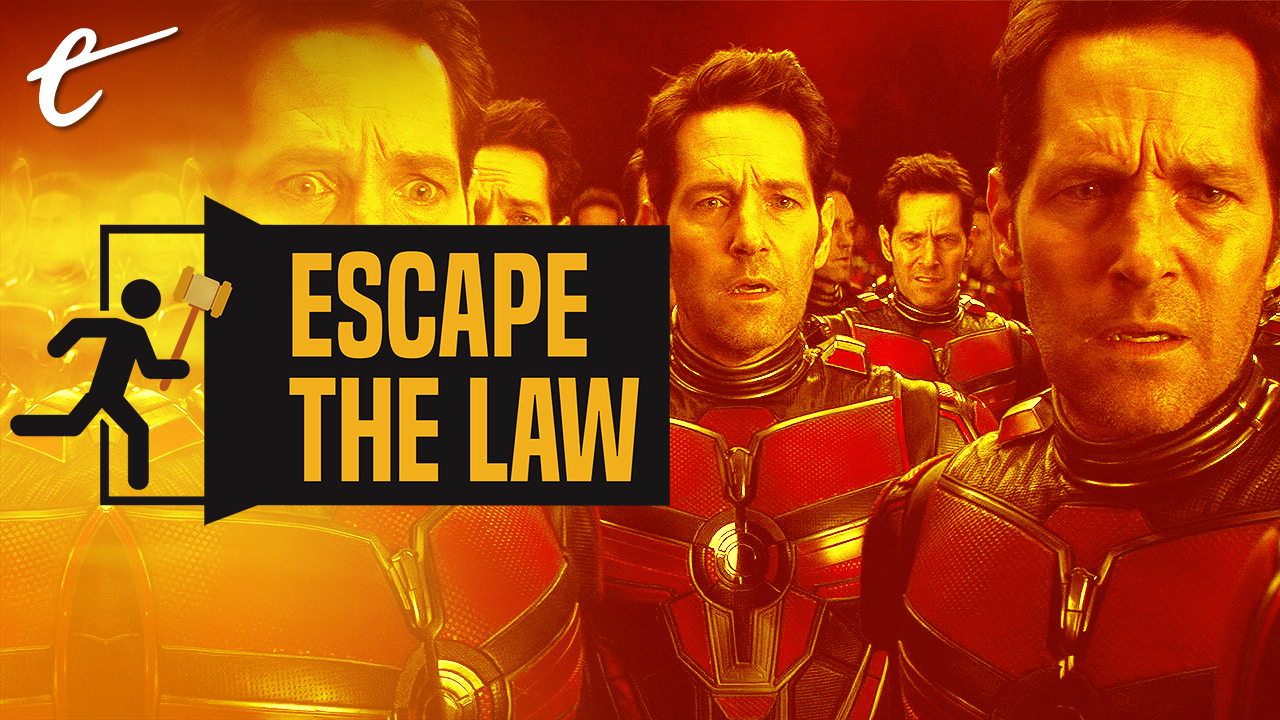There’s a rule in physics: When you go really big or really small, weird things happen. At extreme scales, you can fit a 20-foot pole inside a 10-foot barn, change the speed of time, or even control the shape of the universe just by looking at it. One of the most prominent concepts from quantum physics is the idea of superposition — the idea that an object can exist in multiple states — or, in fact, in all possible states — at the same time. An ant can be both alive and dead, can exist in Las Vegas and Miami, and can be both one week old and one month old, all at the same time. In these circumstances, none of the rules that govern our day-to-day macro lives apply, and basic concepts like cause-and-effect or physical placement break down. Ant-Man and the Wasp: Quantumania takes advantage of these unusual mechanics and turns them into a fascinating plot device.
In order to save his daughter Cassie (Kathryn Newton), Scott Lang (Paul Rudd) — who has already shrunk down to subatomic size — must shrink down even more in order to retrieve some kind of power core / MacGuffin-type device. Once he reaches that sub-sub-atomic level, things get weird. Ant-Man finds himself in a “probability storm” where all possible versions of himself exist at the same time. Thus, a new Scott Lang is created at each possible decision point. For example, if Lang decides to take a step forward with his left foot, an infinite number of “new” Langs would appear — one who decided to step with the right, another who decided not to step, another who decided to hop forward with both feet at the same time, another who decided to take a slightly longer step, and so on.
But the probability field doesn’t stop there. Each subsequent version of Lang makes additional decisions of his own, each of which itself yields another infinite set of Langs. Instantly, there is an infinite number of Ant-Men that make the “many Smiths” scene in The Matrix Reloaded look like one of the tumbleweed scenes in an old western.

Liability in a Probability Storm Like the One in Quantumania
The science behind probability storms is interesting. But the deeper and (arguably) more challenging questions speak to the legal challenges that would arise in a probability storm. After all, if anything that could happen does happen, then how could anyone ever be viewed as morally or legally responsible for anything? For example, at any given moment, it is possible for one person to murder or decide to murder another.
In the real world, that possibility is meaningless, since it would never come to pass — it is, at most, a fleeting, improbable event. In a probability field, however, that possibility would become reality, and most or all people would become murderers. Conversely, if a real-world murderer were placed in a probability field, there would exist an infinite number of people who would have decided to spare the victim’s life or who failed to successfully execute their plan. Thus, one could argue that it would be wrong to assign punishment or blame in a probability storm, since none of the wrongdoers had the ability to avoid taking their bad action and, in fact, were compelled by the laws of physics to break the laws of man.
At first glance, one might think that this problem is too theoretical to be of concern to us. After all, we exist in the macro space, where there is no (visible) superposition or probability storms and where each person only exists in one state at a time. But there is nothing exceptional about the particular state in which we exist. In this world, it may be that you are not a murderer. But that ignores the fact that there is and was a probability that you would have been a murderer had things gone differently.
The fact that you converged into a non-murderous state rather than a murderous one has nothing to do with your moral worth or merit, but is rather the outcome of probabilistic quantum luck, which could just as easily have cut against you. In this way, the legal and moral problems that arise in the Quantumania probability storm are simply a more obvious demonstration of problems that exist in our current world.

The Problem of Moral Luck
But what is the answer? If all of our choices are determined by quantum luck, then how can we justify punishing or judging anyone for anything ever? Legal theorists and philosophers have considered this problem in extensive detail (albeit not in the context of quantum physics). In his landmark essay “Moral Luck,” philosopher Thomas Nagel argues that one’s morality, as traditionally understood, is entirely outside of one’s control, such that one ought not assign moral judgment or blame on anyone about anything ever. Surely that answer cannot be correct. So what are we to do?
Philosophers and legal theorists have devised two general approaches to challenge moral luck. The first approach is to refute the notion that individuals are completely lacking in control. For example, one could argue that some decisions are outside of our control — for example, individuals with severe psychoses or mental impairments — but that, broadly speaking, people have free will and the ability to choose or influence the “moral state” on which they converge.
The second approach is to refute the notion that we cannot or should not judge people for factors outside of their control. Simply put, proponents of this approach argue that society’s rules regarding blame and judgment lead to better outcomes, and thus they should be used regardless of whether they are fair or not. As a simple example, we know that having rules against murder will decrease the likelihood and frequency of murders, regardless of whether the murderer is actually responsible or at fault. Under this utilitarian view, the point of blame or judgment is not to evaluate one’s moral worth, but rather to identify a set of rules that will maximize social wellbeing.

How Probability Storms Can Help Solve the Moral Luck Problem
The concept of a probability storm invites a third potential solution to the moral luck (and quantum luck) problem. This third solution is rooted in math and physics. In a probability storm, there are an infinite number of outcomes that exist at the same time. Infinity is intrinsically intractable and can scarcely even be understood by the human mind. Fortunately, infinity can be understood by the mathematician’s mind, as mathematicians have developed helpful tools to understand, simplify, and conceptualize the infinite. Through use of comparisons and relative evaluations, mathematicians can quantify, manipulate, and exploit infinity to suit their purposes. For example, while 1/x and 1/(2x) both reach infinity as x approaches zero, 1/x approaches infinity twice as fast. There is no reason why lawyers and philosophers can’t do the same.
In a probability storm, anything that can happen does happen, leading to an infinite number of each possible version of each person. But that doesn’t mean that probabilities cease to have meaning, nor does it mean that each outcome is equally likely. For example, there may be a version of Scott Lang who murdered his daughter Cassie. That version, however, would be an extreme minority, since 99.999+% of Scott Langs are loving and caring fathers. Thus, in a probability storm, an infinite number of murderous Langs would exist, but they would be created at a much lower rate than non-murderous Langs, as non-murderous Langs would comprise a much larger proportion of the outcome space.
This notion of relative probabilities and frequencies is exactly what we need to cut through the infinitude and reclaim our ability to judge. Instead of assigning blame or liability based on an individual’s actions, we can assign liability based on the distribution of outcomes in the probability space. In the quantum realm, this means we would assign judgment by taking stock of the relative ratios or frequencies of the Lang variants. For example, we would assign more blame or judgment on Lang if 10% of Langs in the probability storm were murderers than we would if 0.5% or 1% of Langs were murderers. By the same token we would assign zero blame with respect to Lang-versions that are basically nonexistent relative to the rest of the group (for example, whale Langs, or Langs who perpetrated mass murder).

We can apply the same kind of reasoning in the real world (albeit not to the same level of precision) by assigning judgment and blame based not on the outcome of any particular action, but rather on how that action impacts the shape and distribution of outcomes in the probability space. Under this reasoning, a person would be subject to blame and liability for actions or decisions that increase the likelihood of negative outcomes, and they would be subject to praise for actions or decisions that decrease the likelihood of negative outcomes.
As a simple example, a person who shoots and kills another would not be subject to blame because they killed someone, but rather because they took action that made the other’s death more likely (probabilistically). By the same token, the perpetrator’s judgment, blame, and liability would be the same even if the victim were to avoid the bullet. By the same token, a person with a significant anger problem (for example, Bruce Banner) would not be subject to liability for entering a destructive rampage — an act outside of their control — but rather for taking steps that would make the rampage more likely or, conversely, for failing to take steps to make the rampage less likely.
The probabilistic approach is not a complete solution to the moral luck dilemma, since it assumes that individuals have at least some ability to influence the probability space and are not simply entities who are subject to external probabilities outside their control. Nevertheless, the approach is still useful since it provides a framework that can be used to assign judgment and liability for acts that are within one’s control, even where the outcome of those actions is subject to the whims of probabilities.

Conclusion
In physics, things get weird when you get really big or really small, and it turns out that the same is true in law. When it comes to the “really big,” we have companies that are beyond the reach of the law because they are “too big to jail,” leaders who are so important they can claim broad “executive privileges” that no other citizen enjoys, and countries that, by virtue of their size and threat, can ignore all international norms and rules. When it comes to the “really small,” we have people who are viewed as so insignificant that they have no legal identity and geographic areas so small that they fall in a legal void where no crimes can be prosecuted.
While the context is different, these legal problems can prove just as intractable as superposition, Schrödinger’s cat, or the probability storm in Ant-Man and the Wasp: Quantumania. Yet, as in physics, finding the right approach can be a matter of perspective. From one vantage point, one might see an infinite number of murderous Scott Langs and an infinite number of dedicated fathers. Yet, from another vantage point, one would see that for every murderous Scott Lang, there are 10,000 upstanding-citizen Langs (not to be confused with the infinite number of Citizen Kanes or Citizen Kangs). Both perspectives are correct, but they carry different meanings.
The same perspective shifts exist in law, at least when it comes to liability and agency. An individual may lack control over the outcome of their actions, but they can nevertheless have extensive control over the circumstances and events that led to their actions in the first place. As with quantum physics, both perspectives are correct, but they carry different meanings. The challenge — which is yet unsolved — is to figure out when and how to use one perspective versus another.
Here’s hoping the physicists can crack that nut. In the meantime, I’ll just go back and watch Quantumania again. After all, we know that to observe something is to change it, and with a 48% Rotten Tomatoes score, Quantumania could use all the observation it can get.





